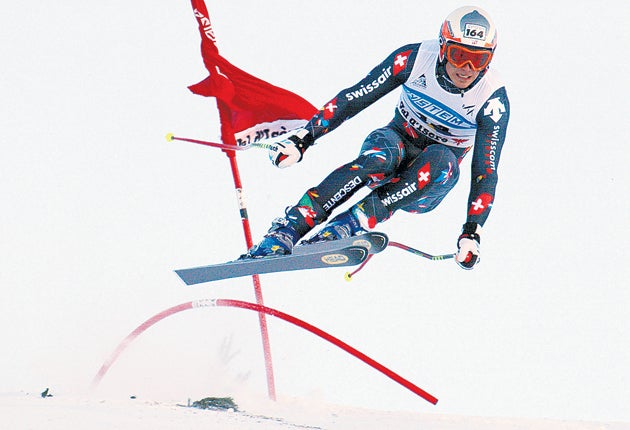How I lost my heart to the supermen of the slopes
The downhill skiers risking all in the quest for gold today are more than racers living on the edge – they are the ultimate Olympians

"I just hope you don't end up asking yourself a question some folks ask me: 'What's he do it for?'"
"Well, I'll be famous. I'll be a champion."
The father gives his son a withering look. "World's full of those..."
Dave Chappellet – played by Robert Redford – is being rebuked by his dad in the 1969 classic Downhill Racer.
The author of their exchange, James Salter, was no ski racer. But he was a fighter pilot, and so had a true affinity with his subject. In reality, of course, the world is not full of such men. The one who wins downhill gold in Whistler today will be only the 17th.
The 10th, Bill Johnson, was asked what his medal meant to him. His answer was infamous. "Millions," he said. "We're talking millions." Nowadays Johnson shuffles round a trailer in remote Oregon. Neither body nor brain is what it was since he smashed himself up in a poignant, hopeless comeback, nine years ago.
Johnson's achievement, as the first American to win downhill gold, was anticipated by Redford's character in Downhill Racer. It seemed a ludicrous prospect, then, but everything else about the film was scrupulously observed. Redford had followed the American downhill team round the Alps, including the Grenoble Olympics in 1968. And he came away with this spare, withdrawn, ruthless character, three parts of the way to an existentialist paradigm. But then, critically, there is something else. Chappellet wants to be a champion.
And that is what downhill skiers do. They achieve a precarious tension between the clinical and the wild. There are some who crave the rush, and that is something you can only ever get if you know fear. But this is not a devil-may-care business. These men must recognise the point of no return, literally and precisely. These are control freaks with a difference: freaks with control.
As a skier, Redford was no more than an "upper ego intermediate" and duly needed an action double. In the event, Joe Jay Jalbert skied so dexterously with a camera that he opened the door to an award-winning career as a film-maker. In his documentary, The Thin Line, a former racer, Chad Fleischer, tells Jalbert that downhill is about "being 100 per cent in control of being 100 per cent out of control ... about living on that ragged edge, on that threshold where you can either be paralysed, dead or a champion."
Dr Jim Taylor knows all about that. Once an international skier himself, he is nowadays a sports psychologist in California. "The challenge is to find that line – that point that's as far as you can go," Taylor says. "If you push that line, you crash and burn; but if you don't go to the line, then you're going to be too slow."
No particular personality type seems more or less disposed to identify that limit. They all find their own way to the same place. "Watch them in the start area," Taylor says. "You see some guys listening to heavy metal, banging their heads against the snow; others off by themselves, meditating. They all have their own way to cope, leading up to two minutes of chaos."
Earlier this week the dangers embraced by these men were explored by another Olympian Johnson – the sprinter, Michael – for a BBC documentary. There were some excruciating images: rag-doll figures bouncing down the mountain, their helmets wrenched off by the deadly forces that in 2001 confined one especially humbling interviewee, Silvano Beltrametti, to a wheelchair.
Johnson discovered that his subjects were not fearless. Instead they knew how to strip panic out of fear. They knew that tension would stifle instinct, perhaps fatally. And that is something that makes sense to any of us who get past even the nursery slopes. However shattering the demands on their physique, their intrusion on gravity is marginal. And, in turn, their intrusion on the life forces within is barely a caress.
Taylor acknowledges that some seek out the adrenalin. "But the idea that downhillers are crazy doesn't make sense," he adds. "Crazy downhillers either die, or become seriously injured. In fact, some of them are athletes of a most rational and methodical type. They do everything they can to minimise risk."
For downhill skiers to become the idols of a boy raised on a Suffolk plain is barely a footnote to the great incongruities upon which their necks depend. All it took was 105 seconds of a 22-year-old Franz Klammer in 1976. For those of us to whom the Winter Games mean rather more than some compatriot camping it up on ice, the downhillers – these headlong, heedless supermen – are the ultimate Olympians. You can keep your velodromes.
These days Taylor can cruise down a course like Beaver Creek, after a race, and be dumbfounded. "It's so steep, so icy, that even for someone like me it's pretty scary," he says. "For guys to fling themselves down that pitch, it's shocking really."
But as Fleischer told Jalbert: "You put your poles over the wand at the start house, you look down, and it's totally quiet at that point because you're so in the zone. 'This is what I live for, man! This is it!'"
In November, at Lake Louise, Canada's world downhill champion knew even as he slithered over the ice that his leg was broken and he would miss his home Olympics. Lying in his hospital bed, John Kucera gave a shrug: "If I didn't want to get hurt, I'd be a badminton player."
Join our commenting forum
Join thought-provoking conversations, follow other Independent readers and see their replies
Comments